Application of Scattering Parameters to DPL Time-Lag Parameter Estimation at Nanoscale in Modern Integration Circuit Structures
Abstract
:1. Introduction
- The verification of new simulation tools dedicated for the design of experimental application specific integrated circuits (ASICs).
- Estimation of IC material parameters for the nanometric technologies.
2. Heat Transfer at the Nanoscale
- Modified boundary conditions, the DPL model simplification, and numerically effective 3D harmonic temperature models’ representation were presented in [1];
- Internal heat generation source analysis and its realistic approximation were presented in Appendix A and [19] (pp. 12–13 in Appendix A);
- No crystalline and amorphous materials (Fournier and Boccara [38]).
3. Test Structure
4. Test Structure Models and Measurement Process
4.1. Thermal Model
- The upper side of the structure—the heat-free convection is encoded using Neumann boundary condition with a heat transfer coefficient equal to 658.763 W/(m2K).
- The left and right side of the structure—the symmetry is applied using Neumann boundary conditions.
- The Dirichlet boundary condition for the bottom side of the structure Tr = Tambient, Ti = 0.
4.2. Electrical Analysis and Final Measurement Procedure
- The upper and lower resistor lengths are very short compared with the wavelength at f ≈ 300 MHz. Therefore, the distributed character of both resistors shall be taken into account for f > c/(20 L εr−1/2) ≈ 64 GHz, where c is the speed of the light in the vacuum, and the relative electric permittivity of SiO2 is equal to εr ≈ 3.9. Consequently, only a de-embedded procedure for a PCB is required for the PCB transmission lines’ elimination [2].
- The investigation presented in [2] shows that the eddy-current losses (and skin effect) in a conductor and dielectric losses can be neglected with a 1.4% error up to 10 GHz and an error lower than 0.3% up to 2 GHz.
- The extracted parasitic parameters in Table 2 show that inductance and capacitance can be neglected for f ≈ 300 MHz.
- It should also be noted the self-heating can be neglected for a small current flowing through the platinum resistor (e.g., Ibottom ≤ 5 mA [44]).
- As can be noticed, the application of the network analyser allows for the direct measurement of the power wave transmitted through the MEMS test structure s12 = s21, which represents the insertion loss of the analysed network. To determine the temperature time-lag delay, we used the s21 measurements for a frequency close to f = 150 MHz (n = 21 spot frequency points in the range 145 MHz ≤ f ≤ 155 MHz) and determined the averaged value and standard deviation of this parameter arg(s21) = 62.3219 (±0.676051)° at f = 150 MHz, with the sum of error squares (SS) = 9.01973 and degrees of freedom (DOFs) = 21 (see Figure 5). Finally, the temperature time-lag delay can be calculated from Equation (8):
4.3. Results and Discussions
5. Conclusions
Supplementary Materials
Author Contributions
Funding
Institutional Review Board Statement
Informed Consent Statement
Data Availability Statement
Acknowledgments
Conflicts of Interest
Appendix A. Analysis of Dissipated Power and Internal Heat Generation Source in MEMS Test Structure
References
- Zubert, M.; Raszkowski, T.; Samson, A.; Zając, P. Methodology of determining the applicability range of the DPL model to heat transfer in modern integrated circuits comprised of FinFETs. Microelectron. Reliab. 2021, 91, 139–153. [Google Scholar] [CrossRef]
- Zubert, M.; Raszkowski, T.; Samson, A.; Janicki, M.; Napieralski, A. The distributed thermal model of fin field effect transistor. Microelectron. Reliab. 2016, 67, 9–14. [Google Scholar] [CrossRef]
- Raszkowski, T.; Samson, A.; Zubert, M. Influence of temperature and heat flux time lags on the temperature distribution in modern GAAFET structure based on Dual-Phase-Lag thermal model. Microelectron. Reliab. 2018, 86, 10–19. [Google Scholar] [CrossRef]
- Raszkowski, T.; Samson, A.; Zubert, M.; Janicki, M. Comparison of temperature distributions in modern nanostructures based on different parameters of Dual-Phase-Lag equation. In Proceedings of the 2018 IEEE 20th Electronics Packaging Technology Conference (EPTC), Singapore, 4–7 December 2018; pp. 290–295. [Google Scholar]
- Zubert, M.; Jankowski, M.; Kulesza, Z.; Napieralski, A. Modelling of Transmission Lines Inside Modern Integrated Semiconductor and test boards. IEEE Access 2021, 9, 87182–87195. [Google Scholar] [CrossRef]
- Vrignon, B.; Bendhia, S.; Lamoureux, E.; Sicard, E. Characterization and Modeling of Parasitic Emission in Deep Submicron CMOS. IEEE Trans. Electromagn. Compat. 2005, 47, 382–387. [Google Scholar] [CrossRef]
- Ben Dhia, S. Une Nouvelle Methodologie de Caracterisation de L’integrite du Signal en cmos Submicronique Profond. Ph.D. Thesis, INSA, Toulouse, France, 1998. [Google Scholar]
- Hebboul, S.E.; Wolfe, J.P. Lattice dynamics of insb from phonon imaging. Z. Phys. B Condens. Matter 1989, 73, 437–466. [Google Scholar] [CrossRef]
- Fourier, J.-B.J.; Firmin, D. Théorie Analytique de la Chaleur; Chez Firmin Didot, père et fils: Paris, France, 1822. [Google Scholar]
- Zubert, M.; Janicki, M.; Raszkowski, T.; Samson, A.; Nowak, P.S.; Pomorski, K. The Heat Transport in Nanoelectronic Devices and PDEs Translation into Hardware Description Languages. Bull. Société Sci. Lett. Łódź Série Rech. Déformations 2014, LXIV, 69–80. [Google Scholar]
- Papež, N.; Sobola, D.; Škvarenina, Ľ.; Škarvada, P.; Hemzal, D.; Tofel, P.; Grmela, L. Degradation analysis of GaAs solar cells at thermal stress. Appl. Surf. Sci. 2018, 461, 212–220. [Google Scholar] [CrossRef]
- Gutfeld, R.J.; Nethercot, A.H. Heat pulses in quarto and sapphire at low temperatures. Phys. Rev. Lett. 1964, 12, 641. [Google Scholar] [CrossRef]
- Nabovati, A.; Sellan, D.P.; Amon, C.H. On the lattice Boltzmann method for phonon transport. J. Comput. Phys. 2011, 230, 5864–5876. [Google Scholar] [CrossRef]
- Fosco, C.D.; Losada, E.L. Functional Approach to the Fermionic Casimir Effect Archived 31 May 2011 at the Wayback Machine. Phys. Rev. D 2008, 78, 025017. [Google Scholar] [CrossRef] [Green Version]
- Bordag, M.; Klimchitskaya, G.L.; Mohideen, U.; Mostepanenko, V.M. Advances in the Casimir Effect Advances in the Casimir Effect; Oxford U. Press: New York, NY, USA, 2009; ISBN 978-0-19-923874-3. [Google Scholar]
- Raszkowski, T.; Zubert, M. Investigation of Heat Diffusion at Nanoscale Based on Thermal Analysis of Real Test Structure. Energies 2020, 13, 2379. [Google Scholar] [CrossRef]
- Tzou, D.Y. An engineering assessment to the relaxation time in thermal wave propagation. Int. J. Heat Mass Transf. 1993, 36, 1845–1851. [Google Scholar] [CrossRef]
- Tzou, D.Y. A Unified Field Approach for Heat Conduction from Macro- to Micro-Scales. J. Heat Transf. 1995, 117, 8–16. [Google Scholar] [CrossRef]
- Raszkowski, T.; Zubert, M. Analysis of Algorithm Efficiency for Heat Diffusion at Nanoscale Based on a MEMS Structure Investigation. Energies 2020, 13, 2520. [Google Scholar] [CrossRef]
- Cattaneo, M.C. A form of heat conduction equation which eliminates the paradox of instantaneous propagation. C. R. Acad. Sci. I Math. 1958, 247, 431–433. [Google Scholar]
- Cattaneo, C. Sur une forme de l’equation de la chaleur eliminant le paradoxe d’une propagation instantanee (in French). Comptes Rendus L’Académie Sci. 1958, 247, 431–433. [Google Scholar]
- Pop, E.; Sinha, S.; Goodson, K.E. Heat Generation and Transport in Nanometer-Scale Transistors. Proc. IEEE 2006, 94, 1587–1601. [Google Scholar] [CrossRef]
- Zhukovsky, K. Exact Negative Solutions for Guyer–Krumhansl Type Equation and the Maximum Principle Violation. Entropy 2017, 19, 440. [Google Scholar] [CrossRef] [Green Version]
- Ván, P.; Berezovski, A.; Fülöp, T.; Gróf, G.; Kovács, R.; Lovas, Á.; Verhás, J. Guyer-Krumhansl–type heat conduction at room temperature. EPL (Eur. Lett.) 2017, 118, 50005. [Google Scholar] [CrossRef] [Green Version]
- D’Alessandro, V.; Rinaldi, N. A critical review of thermal models for electro-thermal simulation. Solid-state Electron. 2002, 46, 487–496. [Google Scholar] [CrossRef]
- Vernotte, P. Les paradoxes de la theorie continue de l’equation de la chaleur (in French). C. R. Acad. Sci. 1958, 246, 3154–3155. [Google Scholar]
- Vermeersch, B.; De Mey, G. Non-Fourier thermal conduction in nano-scaled electronic structures. Analog. Integr. Circuits Signal Process. 2007, 55, 197–204. [Google Scholar] [CrossRef]
- Janicki, M.; De Mey, G.; Zubert, M.; Napieralski, A. Comparison of fourier and non-fourier heat transfer in nanoscale semiconductor structures. In Proceedings of the 2014 Semiconductor Thermal Measurement and Management Symposium (SEMI-THERM), San Jose, CA, USA, 9–13 March 2014; pp. 202–206. [Google Scholar]
- Kovács, R.; Ván, P. Generalized heat conduction in heat pulse experiments. Int. J. Heat Mass Transf. 2015, 83, 613–620. [Google Scholar] [CrossRef] [Green Version]
- Tzou, D.Y. Macro-to Microscale Heat Transfer: The Lagging Behavior, 2nd ed.; Willey: Hoboken, NJ, USA, 2015. [Google Scholar]
- Brorson, S.D.; Fujimoto, J.G.; Ippen, E.P. Femtosecond electronic heat-transport dynamics in thin gold films. Phys. Rev. Lett. 1987, 59, 1962–1965. [Google Scholar] [CrossRef]
- Brorson, S.D.; Kazeroonian, A.; Moodera, J.S.; Face, D.W.; Cheng, T.K.; Ippen, E.P.; Dresselhaus, M.S.; Dresselhaus, G. Femtosecond room-temperature measurement of the electron-phonon coupling constant γ in metallic superconductors. Phys. Rev. Lett. 1990, 64, 2172–2175. [Google Scholar] [CrossRef] [PubMed] [Green Version]
- Elsayed-Ali, H.E.; Juhasz, T.; Smith, G.O.; Bron, W.E. Femtosecond thermoreflectivity and thermotransmissivity of polycrystalline and single-crystalline gold films. Phys. Rev. B 1991, 43, 4488–4491. [Google Scholar] [CrossRef] [PubMed]
- Qiu, T.Q.; Juhasz, T.; Suarez, C.; Bron, W.E.; Tien, C.L. Femtosecond Laser Heating of Multi-Layered Metals—II. Experiments. Int. J. Heat Mass Transf. 1994, 37, 2799–2808. [Google Scholar] [CrossRef]
- Qiu, T.; Tien, C. Short-pulse laser heating on metals. Int. J. Heat Mass Transf. 1992, 35, 719–726. [Google Scholar] [CrossRef]
- Qiu, T.Q.; Tien, C.L. Heat Transfer Mechanisms During Short-Pulse Laser Heating of Metals. J. Heat Transf. 1993, 115, 835–841. [Google Scholar] [CrossRef]
- Qiu, T.; Tien, C. Femtosecond laser heating of multi-layer metals—I. Analysis. Int. J. Heat Mass Transf. 1994, 37, 2789–2797. [Google Scholar] [CrossRef]
- Fournier, D.; Boccara, A. Heterogeneous media and rough surfaces: A fractal approach for heat diffusion studies. Phys. A Stat. Mech. Its Appl. 1989, 157, 587–592. [Google Scholar] [CrossRef]
- Jablonski, G.; Janus, P.; Pietrzak, P.; Torzewicz, T.; Sobczak, A.; Janicki, M.; Napieralski, A.; Sierakowski, A.; Brzezinska, A.; Prokaryn, P. Manufacturing and characterisation of MEMS test nanostructures. In Proceedings of the 2017 23rd International Workshop on Thermal Investigations of ICs and Systems (THERMINIC), Amsterdam, The Netherlands, 27–29 September 2017; pp. 1–5. [Google Scholar]
- Janicki, M.; Pietrzak, P.; Topilko, J.; Zając, P.; Sobczak, A.; Jablonski, G.; Janus, P.; Prokaryn, P.; Napieralski, A. Measurement and simulation of MEMS dedicated to investigation of heat transfer at nanoscale. In Proceedings of the 2018 19th International Conference on Thermal, Mechanical and Multi-Physics Simulation and Experiments in Microelectronics and Microsystems (EuroSimE), Toulouse, France, 15–18 April 2018; pp. 1–4. [Google Scholar]
- Zubert, M.; Raszkowski, T.; Topilko, J.; Starzak, L.; Jabłoński, G.; Janus, P.; Janicki, M.; Napieralski, A. Determining Parameters of the Dual-Phase-Lag Model of Heat Flow. In Proceedings of the 2018 25th International Conference “Mixed Design of Integrated Circuits and System” (MIXDES), Gdynia, Poland, 21–23 June 2018; pp. 225–230. [Google Scholar]
- Zubert, M.; Janicki, M.; Zajac, P.; Raszkowski, T.; Topilko, J.; Pietrzak, P.; Jablonski, G.; Samson, A.; Napieralski, A. Assessment of Different Methodologies for The Estimation of DPL Model Parameter Values for Dynamic Thermal Simulations of Nanoscale Electronic Structures. In Proceedings of the 2018 24rd International Workshop on Thermal Investigations of ICs and Systems (THERMINIC), Stockholm, Sweden, 26–28 September 2018; pp. 1–6. [Google Scholar]
- Topilko, J.; Sobczak, A.; Pietrzak, P.; Zajac, P.; Janicki, M.; Janus, P.; Zubert, M.; Napieralski, A. Manufacturing and Characterization of Test Structures Dedicated for The Investigation of Heat Transfer Processes at Nanoscale. In Proceedings of the 2019 25th International Workshop on Thermal Investigations of ICs and Systems (THERMINIC), Lecco, Italy, 25–27 September 2019; pp. 1–4. [Google Scholar]
- Gray, P.R.; Hurst, P.J.; Lewis, S.H.; Meyer, R.G. Analysis and Design of Analog Integrated Circuit, 5th ed.; John Wiley & Sons: Hoboken, NJ, USA, 2009; p. 40. ISBN 978-0-470-24599-6. [Google Scholar]
- Silicon Dioxide. Available online: https://www.microwaves101.com/encyclopedias/silicon-dioxide (accessed on 27 June 2021).
- Hotta, M.; Hayashi, M.; Nishikata, A.; Nagata, K. Complex Permittivity and Permeability of SiO2 and Fe3O4 Powders in Microwave Frequency Range between 0.2 and 13.5 GHz. ISIJ Int. 2009, 49, 1443–1448. [Google Scholar] [CrossRef] [Green Version]
- Nguyen, C. Radio-Frequency Integrated-Circuit Engineering; Wiley: Hoboken, NJ, USA, 2015; p. 896. [Google Scholar]
- Janicki, M.; Topilko, J.; Sobczak, A.; Zajac, P.; Pietrzak, P.; Napieralski, A. Measurement and Simulation of Test Structures Dedicated to the Investigation of Heat Diffusion at Nanoscale. In Proceedings of the 2019 20th International Conference on Thermal, Mechanical and Multi-Physics Simulation and Experiments in Microelectronics and Microsystems (EuroSimE), Hannover, Germany, 24–27 March 2019; pp. 1–4. [Google Scholar]
- Sobczak, A.; Topilko, J.; Zajac, P.; Pietrzak, P.; Janicki, M. Compact Thermal Modelling of Nanostructures Containing Thin Film Platinum Resistors. In Proceedings of the 21st International Conference on Thermal, Mechanical and Multi-Physics Simulation and Experiments in Microelectronics and Microsystems (EuroSimE), Kraków, Poland, 26–29 April 2020; pp. 6–27. [Google Scholar]
- Raszkowski, T. Numerical Modelling of Thermal Phenomena in Nanometric Semiconductor Structures. Ph.D. Thesis, Lodz University of Technology, Lodz, Poland, 2019. (In Polish). [Google Scholar]
- Raszkowski, T.; Samson, A.; Zubert, M. Temperature Distribution Changes Analysis based on Grünwald-Letnikov Space Derivative. Bull. Société Sci. Lett. Łódź Série Rech. Déformations 2018, LXVIII, 141–152. [Google Scholar]
- Sorrentino, R.; Bianchi, G. Microwave and RF Engineering; Wiley: Hoboken, NJ, USA, 2010. [Google Scholar]
- Ramu, A.T.; Bowers, J.E. A “2-omega” technique for measuring anisotropy of thermal conductivity. Rev. Sci. Instrum. 2012, 83, 124903. [Google Scholar] [CrossRef] [PubMed]
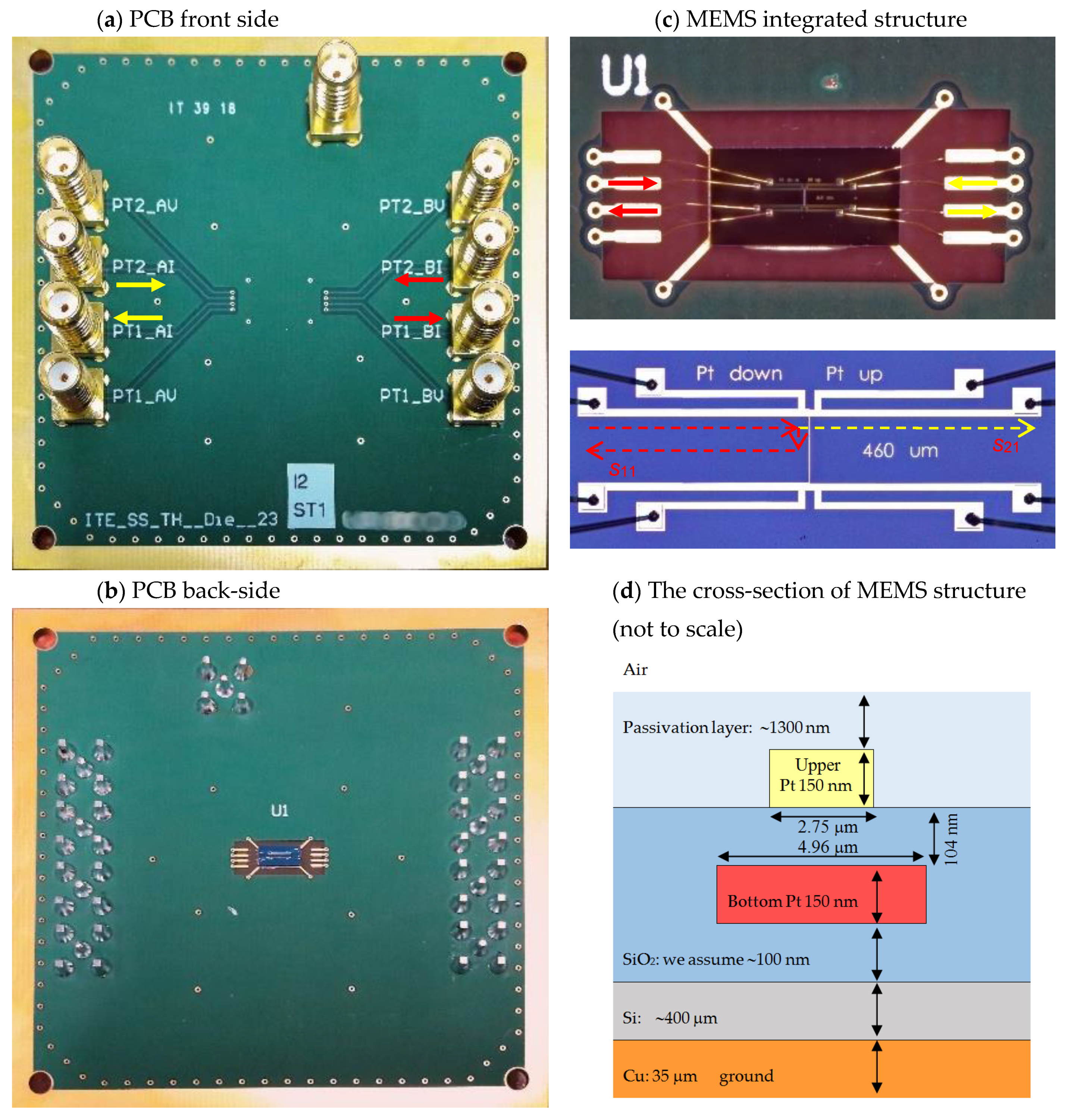
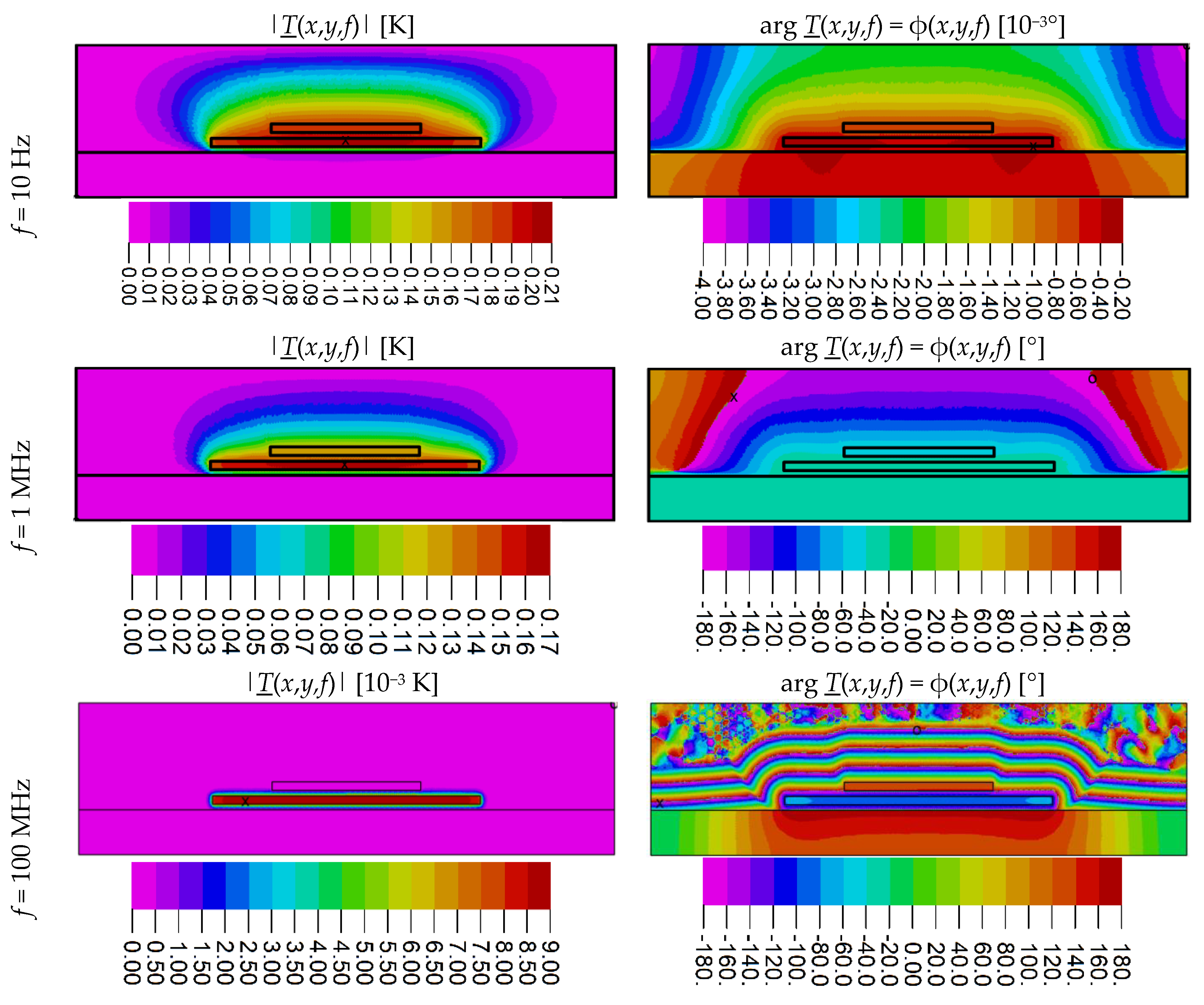
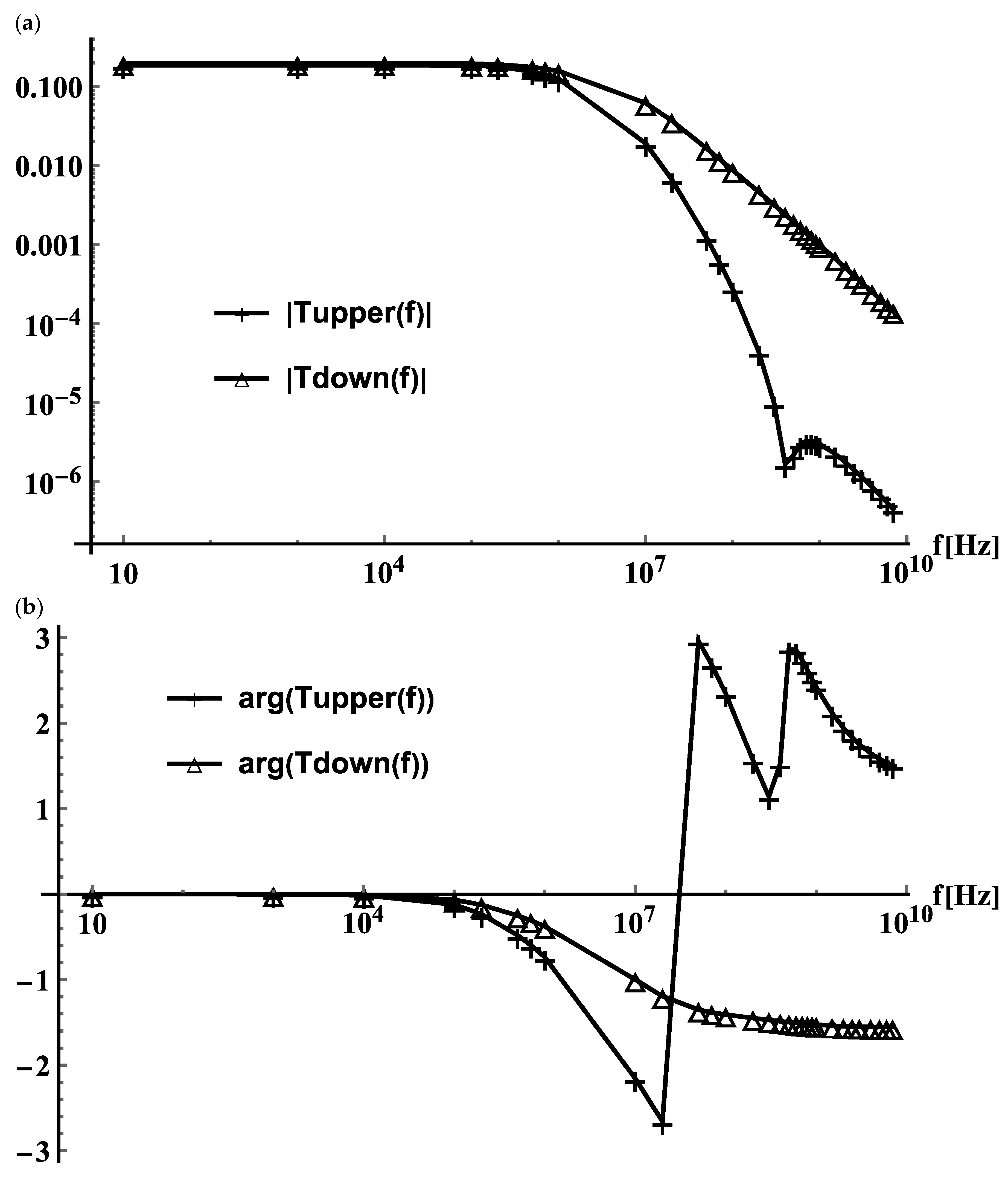
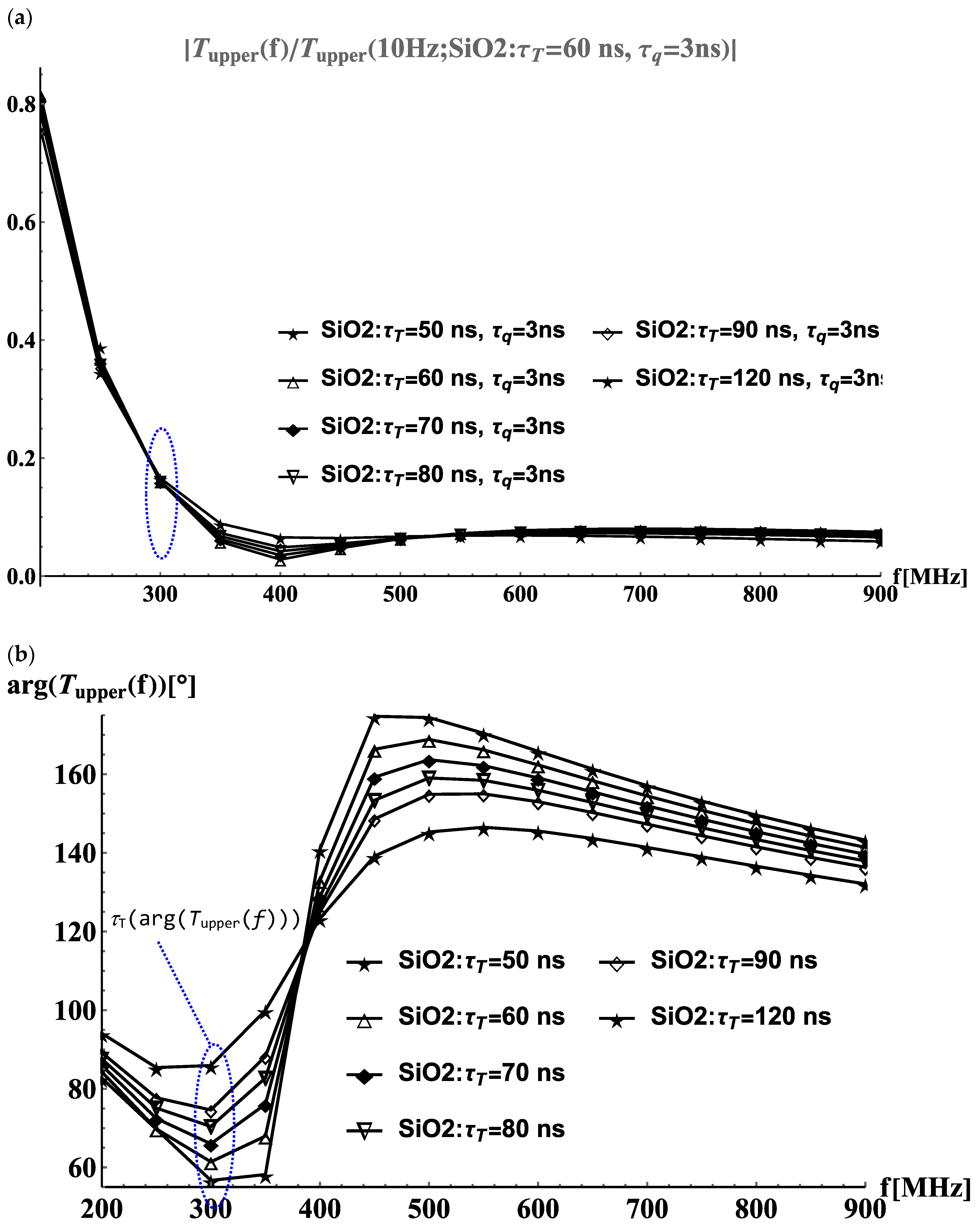
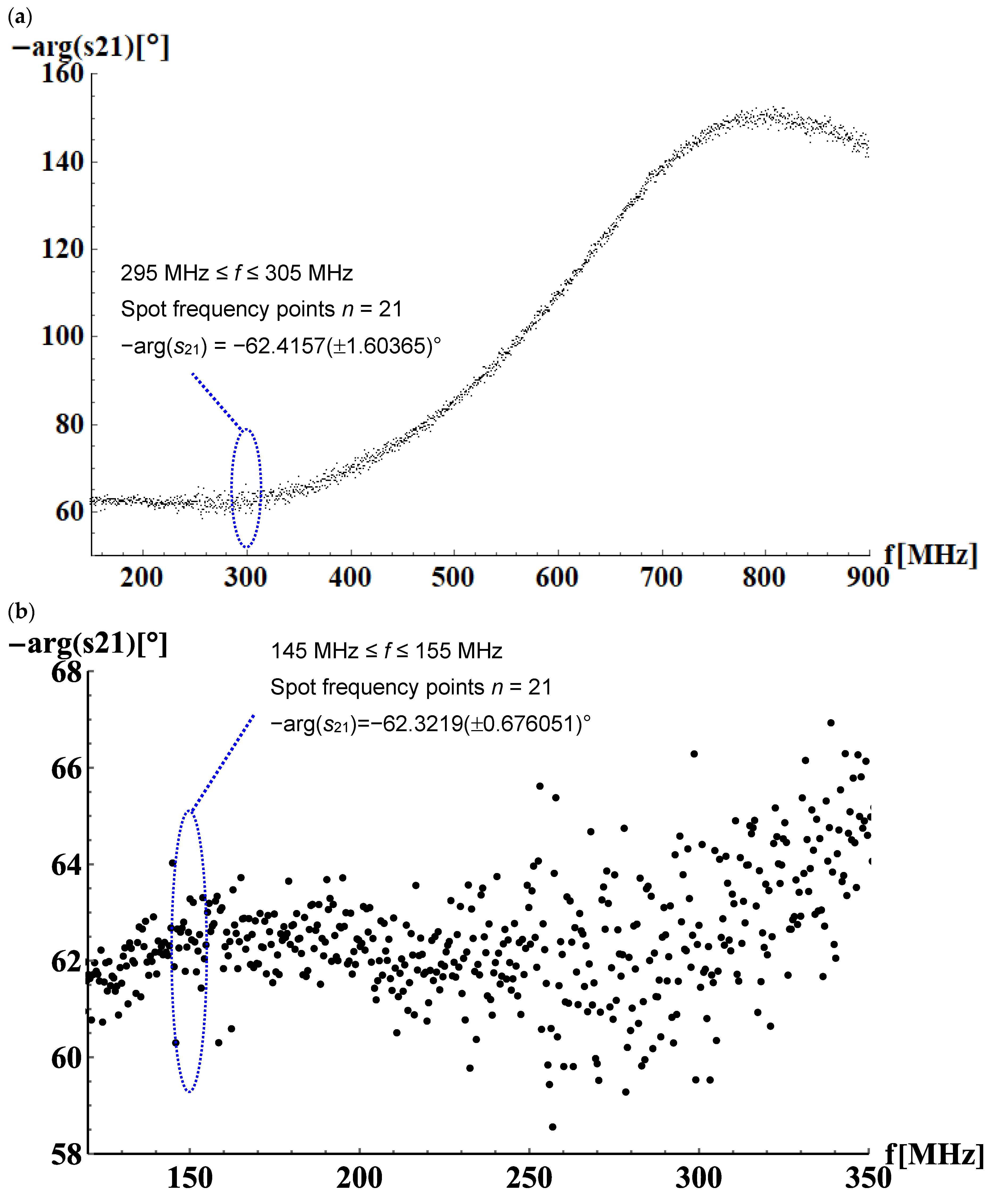
| Material Name | τq [ns] | τT [ns] | ||
|---|---|---|---|---|
| Silicon (Si) | 160 | 1.78 × 106 | 3 | 120 |
| Silicon dioxide (SiO2) | 1.38 | 1.65 × 106 | 3 | predicted: 50–120 |
| Platinum (Pt) | 71.6 | 2.85 × 106 | 0.0916 | 2.6 × 10−12 |
| Conductor | Equivalent Resistance | Equivalent Inductance |
|---|---|---|
| Top resistor (Pt, Wtop = 2.75 μm., h = 150 nm, L = 460 μm) | 155 Ω at 20 °C 0.3045 Ttop + 147.4524 Ω [44] | 6.91443 × 10−10 H |
| Bottom resistor (Pt, Wbottom = 4.96 mm., h = 150 nm, L = 460 μm) | 262.3 Ω at 20 °C 0.5064 Tbottom + 249.6276 Ω [44] | 5.81732 × 10−10 H |
| PCB ground (Cu, Wground = 200 μm, h = 35 μm, L = 460 μm, ρCu = 1.72∙10−8 Ωm−1) | 1.13 mΩ | 2.62057 × 10−10 H |
| Equivalent capacitances and mutually coupled inductances: Ltop-bottom = 5.25685 × 10−10 H, Ltop-ground = 1.90503 × 10−10 H, Lbottom-ground = 1.90799 × 10−10 H, Ctop-bottom ≈ 0.56405 × 10−12 F, Cbottom-ground ≈ 0.631304 × 10−15 F. | ||
Publisher’s Note: MDPI stays neutral with regard to jurisdictional claims in published maps and institutional affiliations. |
© 2021 by the authors. Licensee MDPI, Basel, Switzerland. This article is an open access article distributed under the terms and conditions of the Creative Commons Attribution (CC BY) license (https://creativecommons.org/licenses/by/4.0/).
Share and Cite
Zubert, M.; Kulesza, Z.; Jankowski, M.; Napieralski, A. Application of Scattering Parameters to DPL Time-Lag Parameter Estimation at Nanoscale in Modern Integration Circuit Structures. Energies 2021, 14, 4425. https://doi.org/10.3390/en14154425
Zubert M, Kulesza Z, Jankowski M, Napieralski A. Application of Scattering Parameters to DPL Time-Lag Parameter Estimation at Nanoscale in Modern Integration Circuit Structures. Energies. 2021; 14(15):4425. https://doi.org/10.3390/en14154425
Chicago/Turabian StyleZubert, Mariusz, Zbigniew Kulesza, Mariusz Jankowski, and Andrzej Napieralski. 2021. "Application of Scattering Parameters to DPL Time-Lag Parameter Estimation at Nanoscale in Modern Integration Circuit Structures" Energies 14, no. 15: 4425. https://doi.org/10.3390/en14154425
APA StyleZubert, M., Kulesza, Z., Jankowski, M., & Napieralski, A. (2021). Application of Scattering Parameters to DPL Time-Lag Parameter Estimation at Nanoscale in Modern Integration Circuit Structures. Energies, 14(15), 4425. https://doi.org/10.3390/en14154425






